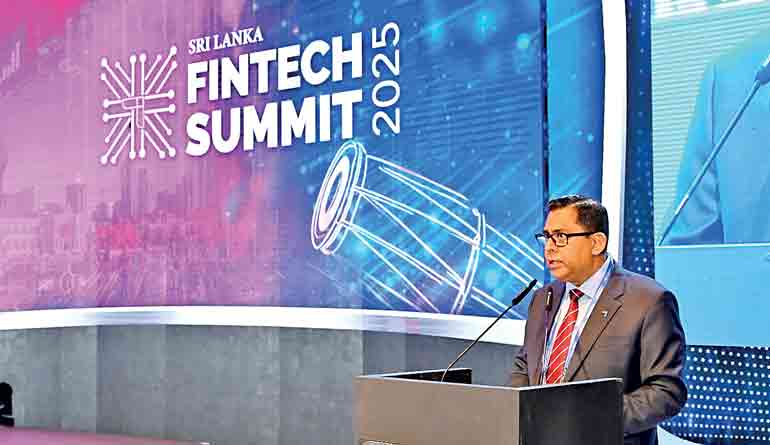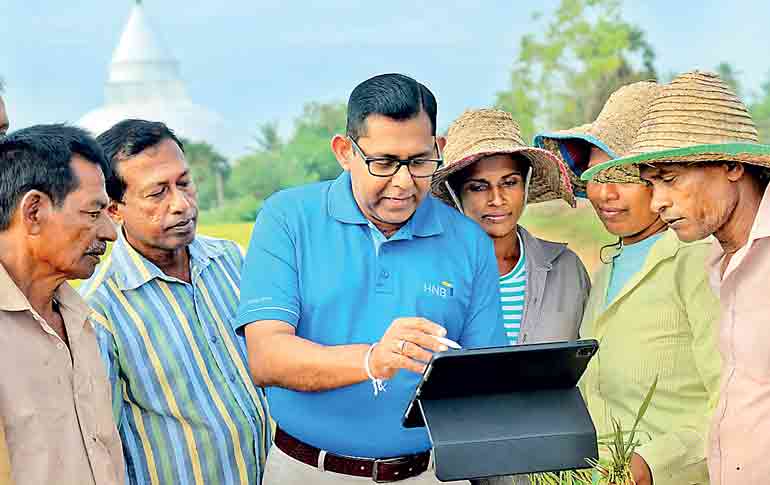Tuesday Nov 25, 2025
Tuesday Nov 25, 2025
Tuesday, 25 November 2025 02:00 - - {{hitsCtrl.values.hits}}

HNB MD/CEO Damith Pallewatte speaking at the opening ceremony of the Sri Lanka Fintech Summit 2025
By HNB MD/CEO Damith Pallewatte
 As the end of the calendar year approaches, Sri Lanka has at last moved from stabilisation into a brittle but very real recovery. The economy is nearing its second full year of positive GDP growth with inflation broadly under control, while foreign reserves are on track to reach around $ 6.5 - 7 billion. A powerful rebound in external inflows – especially a 20% year-on-year increase in worker remittances to nearly $ 6.5 billion by October 2025 – has given our nation badly needed breathing room.
As the end of the calendar year approaches, Sri Lanka has at last moved from stabilisation into a brittle but very real recovery. The economy is nearing its second full year of positive GDP growth with inflation broadly under control, while foreign reserves are on track to reach around $ 6.5 - 7 billion. A powerful rebound in external inflows – especially a 20% year-on-year increase in worker remittances to nearly $ 6.5 billion by October 2025 – has given our nation badly needed breathing room.
Yet even as our export sectors and tourism have shown admirable resilience, Sri Lanka’s continued dependence on remittances is a reminder that deeper reforms remain overdue. Many families are still one shock away from falling back into hardship. Thousands of SMEs are working harder than ever simply to stay afloat. Meanwhile, global supply chains are being rewritten amidst geopolitical headwinds, technology is reshaping industries, as our regional competitors race to embed digital infrastructure and high-value production into their economies.
Sri Lanka’s road to 2030 will therefore be defined not only by how we repair the damage of the past, but by how effectively we reposition our nation to compete in this new global economic paradigm.
The opportunity cost of cash – and why digital is a competitiveness agenda
Budget 2025 set a clear and aggressive vision – to grow the digital economy to 12% of GDP by 2030. That implies expanding ICT export revenues from about $ 1.2 billion today to around $ 5 billion, and growing the tech talent pool from 85,000 to roughly 200,000 professionals. Together with a new Digital Economic Authority, a Rs. 3 billion allocation for digital-economy development, and investments in Digital Public Infrastructure – from Secure Transaction Registries (STR) and a national digital ID to the digitisation of Government payments – the direction of travel is clear.
But these are ambitious goals, and they cannot be achieved unless the banking and financial services industry lifts itself to match that ambition. Our growth plans as banks can no longer run on separate tracks; they must be consciously aligned with the country’s 2030 vision.
Despite progress, Sri Lanka is still heavily cash–dependent, with around Rs. 1.5 trillion in circulation and an estimated 1.5% of GDP spent just to print, move and secure notes and coins – almost as much as we allocate to education and higher education combined.
In effect, we are leaving on the table a sizeable dividend that could instead be invested in classrooms, healthcare and infrastructure. That is the real opportunity cost of cash, and why digitalisation is not just about convenience but competitiveness.
Early moves like GovPay – now linking over 200 state institutions and having already crossed Rs. 1 billion in transactions – and the planned Sri Lanka Unique Digital Identity (SL-UDI), together with a STR for movable assets, show what is possible. In time, SL-UDI will become a primary credential for everything from welfare to banking, while the registry will give banks greater confidence to lend against specific assets – from a backhoe to a generator – knowing they have not been pledged multiple times. That reduces fraud, frees up capital and helps SMEs and households build the kind of verifiable track record that supports better-priced credit.
Over time, this enables banks to complement traditional collateral with clear evidence of responsible financial behaviour and to channel more credit into businesses and sectors with real potential to lift productivity and also earn foreign exchange.
If DPI builds the rails, SMEs, agripreneurs and export-oriented firms will determine what moves on them given that they already account for the majority of businesses and around half of GDP. Joining these rails can create a positive feedback loop in which good financial management leads to easier access to working capital and fairer pricing across the board.
Through programs like Gami Pubuduwa and Sarusara, we have seen that rural entrepreneurs are not resistant to change – they just need access to value chains, tools and language that fit their realities and work for them. So farmers can become agripreneurs who adopt technology, add value and capture more of the margin. The same logic applies across priority sectors: Sri Lanka must grow exports rooted in local produce and know-how – seafood, spices, fresh fruit, processed foods, handicrafts and wellness tourism – where almost every dollar earned is retained in the country and supports high-quality jobs.
The new engines of growth: Turning remittances and talent into a competitive edge
Worker remittances have been one of the quiet heroes of Sri Lanka’s recovery – unlike exports, they are a pure foreign exchange inflow, and the hard earned foreign currency wired back home by our migrant workers is directly added to our national balance sheet. Yet a significant share still moves through informal channels, often for a marginally better rate, and some simply for convenience.
The real opportunity for banks is to move beyond this “rate war” with propositions like HNB Adhisthana takes a value-centric, long-term approach – opening accounts before departure, routing salaries through the formal system, and linking that history to tangible benefits such as education, housing and vehicle finance for families living in Sri Lanka.
A similarly holistic lens must guide how we think about talent. Brain drain is certainly a challenge, but Sri Lanka has seen many such waves of talent migration. Ultimately, to stem it, we must be build opportunity for those who chose to stay, weather the storms, and continue to build their lives in Sri Lanka. In every sector, we have seen younger professionals step into responsibilities that traditionally took a decade or more to reach.
Supported by unprecedented access to information and digital tools – including AI and micro-learning – many are accelerating their development at a remarkable pace. If we can replicate their success at scale, Sri Lanka could be on the verge of a transformative leap forward in productivity.
Our greatest task as leaders is to connect this young, fresh creativity with purpose: to back new ventures where young Sri Lankans are already excelling: from high-value start-ups to digital and creative industries, differentiated tourism and new export niches, our role must be to recognise and support them to establish new engines of growth, moving away from our limited and narrow export basket.
HNB’s Road to 2030: Redefining ideas of partnership and progress
By 2030, banking will not look the way it does today. But as a set of essential services that enable people and businesses to transact, save, invest and manage risk – banking will be more deeply embedded in everyday life than ever before.
For an institution that has served as a partner in progress to all Sri Lankans for the past 137 years the journey to 2030 is built around three ideas. First, to continue our digital drive – building and adopting systems that make it seamless for customers to use banking in the background of their lives and businesses.
Second, to embrace a partnership-led model in technology – surrounding ourselves with fintechs increasingly will take up the front end of customer engagement, while we provide regulated infrastructure, capital and risk expertise at the core, increasingly on revenue-share models.

By providing farmers with the right tools, language and market links, traditional cultivators can step up as tech-enabled agripreneurs
Third, as a domestically systemically important bank, to evaluate regional expansion, so that we can partner Sri Lankan businesses as they look outward to larger markets.
None of this can come at the expense of sustainability. Investments into renewable energy and local manufacturing capacity are no longer just sectoral priorities; they are balance-of-payments priorities in a country that imports most of its fuel, pharmaceuticals, food and construction materials. Banks have to be at the centre of financing this shift.
Ultimately, Sri Lanka’s competitiveness in 2030 will depend on whether our financial ecosystem evolves in step with these needs. We cannot afford a future where policy sets one direction, the private sector pursues another, and the financial system sits somewhere in between.
Regulators, banks, fintechs, capital-market participants and development partners to align behind a shared vision: a Sri Lankan financial ecosystem that is robust, inclusive and digitally enabled, and which channels capital towards productivity, exports, sustainability and human potential.
If we can achieve that alignment, the recovery we are experiencing today will not be a brief respite, but the foundation of a more resilient, competitive Sri Lankan economy – one in which banking quietly does its job in the background, and our people and enterprises take centre stage.